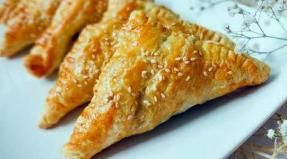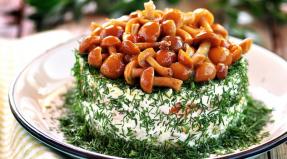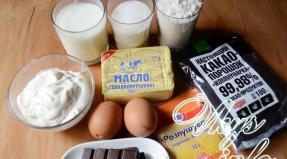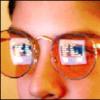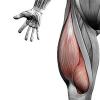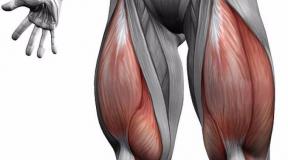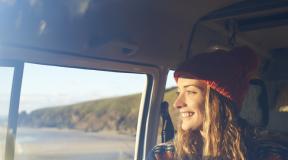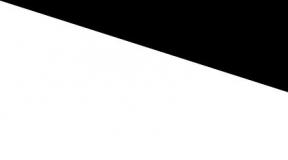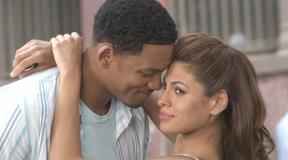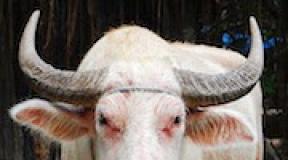How to pump up legs at home. Making legs strong and beautiful
But leg exercises have a number of features. Let's look at how to pump up legs at home for a girl and a man.
Anatomy
To learn how to swing your legs correctly, you first need to figure out how they work and how they work. Next, we will consider each component in order.
The thighs are made up of three muscle groups:
- the front muscles that flex the thigh, called the quadriceps, that is, the quadriceps muscle;
- the posterior muscles that extensor the thigh, called the biceps femoris, that is, the biceps muscle;
- medial muscles that adduct the thigh.
The quadriceps femoris, or quadriceps, is located on the front of the thigh and is the largest and strongest muscle in the human body.
The main function of this muscle is a powerful extension of the leg at the knee. It is called the quadriceps because it consists of four different muscles:
- straight- the longest of all;
- lateral- a large muscle, which is located on the outside of the leg;
- medial- teardrop-shaped muscle, which is located on the inside of the leg;
- vastus intermedius, which is located between the lateral and medial.
Though The quadriceps is the largest and strongest muscle in the front of the leg. She is far from the only one.  The adductor muscles also belong to the anterior muscles of the thigh: comb, tailor, thin and adductor (short, long and adductor). These muscles are called adductors, since they are the adductors of the thigh.
The adductor muscles also belong to the anterior muscles of the thigh: comb, tailor, thin and adductor (short, long and adductor). These muscles are called adductors, since they are the adductors of the thigh.
The back of the thigh is the biceps muscle (biceps femoris), which consists of two muscles: the semitendinosus and the membranous muscles.
The main function of the posterior muscle group is flexion of the legs at the knee joints and extension of the torso during movement of the lower leg.
The gluteal muscles are also referred to as the muscles of the lower extremities. In all, the gluteus maximus muscle is considered the thickest and largest. It starts at the pelvic bone and is attached to the back of the femur just below the hip joint.  She pulls the leg back in the course of the existence of the hip. The gluteus maximus muscle is the most active when climbing a step, as it helps to straighten the hip joint.
She pulls the leg back in the course of the existence of the hip. The gluteus maximus muscle is the most active when climbing a step, as it helps to straighten the hip joint.
It should also be said about the middle and small gluteal muscles. They lie under the large one, and thanks to their pumping, the buttocks look more rounded and attractive. To obtain the best aesthetic result, all three muscles should be trained.
Did you know?There are about 650 muscles in the human body.
The muscles of the leg are represented by two parts: the gastrocnemius, located on the surface, and the soleus, which is hidden under the gastrocnemius. As in the case of the glutes, for the best effect, you need to swing both muscles of the lower leg.
The soleus is one-piece, as it passes exclusively through the ankle joint. The gastrocnemius is two-part, as it passes through both the knee and ankle joints.  The calf muscle has two heads: lateral and medial. Their surface is represented by strong bundles of tendons. The gastrocnemius is much larger than the soleus in size and occupies the bulk of the lower leg.
The calf muscle has two heads: lateral and medial. Their surface is represented by strong bundles of tendons. The gastrocnemius is much larger than the soleus in size and occupies the bulk of the lower leg.
The thick and flat soleus muscle lies under the gastrocnemius, it is much smaller in size, but at the same time performs an equally important function.
Best Exercises
Later in the article, we will look at the best and most effective exercises for training legs, including those that can be performed at home. If you have always been interested in the question of how to quickly pump up your legs at home, carefully study the following sections.
Squats
This exercise is considered a classic, because, according to professional trainers around the world, it is the most effective for bringing the lower limbs into tone.
Squats will give more results than all other exercises, including helping to pump up not only the hips, but also other muscle groups. How to do squats:
How to do squats:
- Go to the rack with the barbell, stand under it so that the neck is located on the upper back (on the trapezoid).
- Grasp the bar with your hands so that it is comfortable and there is a good fixation.
- Tighten and straighten your back, take the bar off the rack, take a step back (but do not go too far, as it will be difficult to work with more weight later on).
- Place your feet shoulder-width apart and rest your entire foot on the floor very firmly.
- Next, keeping your back straight, squat so deep that your upper thigh is parallel to the floor (the deeper you squat, the better the workout).
Important! While squatting, look straight ahead. If you look around, you will lose your balance, and then injury cannot be avoided.
It should also be said about the position of the feet during training:
- If you put your feet shoulder-width apart, you will pump up the quadriceps more.
- In order to increase the load on the muscles of the inner thighs, place your feet wide.
- Narrow stance will allow you to pump up the outer part of the thigh more.
Leg press in the simulator
If your goal is to massively pump up your legs, this exercise is for you. It is also done if there is a risk during barbell squats.
If you have the opportunity to do both the squat and the leg press, do it, it will allow you to pump up big powerful hips.
How to do leg press:
- First of all, you should choose the right exercise on the simulator, in which the buttocks and lower back will not come off the seat of the simulator, otherwise there is a very high risk of injury.
- Place your feet firmly in the middle of the platform, your feet should be shoulder-width apart or slightly narrower.
- Firmly grasp the handles of the simulator with your hands on the sides of the seat, hold on to them until the end of the exercise, this will give stability to the torso.
- After that, remove the platform from the racks and slowly lower it towards you as deep as possible so that your knees touch your chest. Next, squeeze the platform up, but do not fully unbend your knees, so as not to relax the quadriceps and injure the knee joint.
Lunges with a barbell (or dumbbells)
Lunges are recommended to be performed on a Smith machine, as there will be no need to worry about balance. This exercise is also performed at home or with dumbbells.  How to do barbell lunges:
How to do barbell lunges:
- As with the barbell squat, place the bar on your back (traps).
- Take a big step forward with one foot, feet should be on the same line. Maintain a distance between your legs so that when you get down on one knee, both legs should be bent at a right angle.
- The bar should be on the trapezoid while one leg is in front and both feet are in line. Next, begin to drop to one knee, lightly touching the floor (do not hit the knee on the floor, as you will get injured), then return to the starting position.
- It is recommended to first lunge on one limb, and then on the other.
Did you know? When walking calmly, a person uses about a quarter of all his muscles.
Hack squats
The Hack Squat is a variant of the back squat. But they allow you to remove a large axial load on the spine.
How to do squats on a hack machine:
- Sit on the simulator, sitting on it, bend your knees, put your feet shoulder-width apart (feet should be placed parallel to each other) in the middle of the platform. Lean the back of the body against the back of the Hack machine, rest your shoulders against the support (the head should pass between the rollers and not come off until the end of the squat).
- Unlock the mechanism of the simulator, but do not straighten up to the end, as this will relax the quadriceps at the top point and create a large load on the knee joint.
- With an inhalation, slowly squat down, as deep as you can.
- At the bottom point, focusing on the heel (not on the toes), push off the platform and straighten your legs. They should not be straightened completely.
Leg extension - isolation exercise, loading only the quadriceps. Use it as the last in a set of exercises or a warm-up.  This exercise does not increase the mass of the hips, because it is isolated and is not used with large weights. Its function is to give a beautiful shape and relief to the upper side of the thigh.
This exercise does not increase the mass of the hips, because it is isolated and is not used with large weights. Its function is to give a beautiful shape and relief to the upper side of the thigh.
After you sit on the machine, place the roller over your feet and slowly straighten your legs.
Lying leg curls
Flexion, like the previous exercise, is isolated and swings the back muscles of the thighs. Fitness trainers recommend doing this exercise at the end of your workout.
You should also not focus on a lot of weight, since the main thing in bending the legs while lying down is the execution technique. Otherwise, there is no point in wasting time on such training. How to do lying leg curl:
- Do not tear your pelvis off the bench of the simulator; it must be firmly pressed all the time.
- The roller should be placed on the back of the foot or slightly above the foot, but not on the lower leg.
- Do not allow the joints to voluntarily and quickly unbend. Try to hold your feet at the top point, then slowly lower the projectile to its original position. Lower it not to the end, do not throw it at the lowest point, otherwise the effect of the exercise will not be so strong.
Rises on socks (sitting, standing)
Calf raises are used to pump up the calf and soleus muscles.  For the lesson to be effective, you need to follow these tips:
For the lesson to be effective, you need to follow these tips:
- the range of motion of the ankle joint should be as large as possible, this stretches the muscles and increases the load;
- use weights in such a way that you can do a maximum of 10-12 repetitions.
- take the bar and lift the bar;
- feet should be shoulder width apart;
- Rise gently on your toes, try not to lose your balance.
- put the desired weight, sit on the simulator and put your knees on the rollers;
- straightens and bends the ankle joint as many times as necessary.
 With dumbbells, the execution technique is somewhat different:
With dumbbells, the execution technique is somewhat different: - sit on a flat bench and take dumbbells, put your feet on a full foot in front of you.
- ask the trainer to put dumbbells on your knees, as doing it yourself is traumatic.
- holding the dumbbells with your hands, unbend your ankle.
If you are new to the gym, then first you need to familiarize yourself with the basic principles of muscle growth, because without this knowledge, muscle growth is impossible.
Basic recommendations for beginners:- Exercises are divided into muscle groups and according to the number of muscles that are involved in the work (isolation and basic). For beginners, it is recommended to do only the basic ones. They are responsible for rapid muscle growth. Basic exercises include exercises using free weights (for example, dumbbells or barbells). Isolation exercises should be avoided. Isolating exercises include exercises on simulators.
- You need to follow the correct order of exercises. You need to start with large muscles, and then move on to small ones.
- For quality exercises, you need to do from 6 to 12 repetitions. This will promote maximum muscle growth. A series of repetitions is called a "set" or "approach".
- For a good muscle load, 3-4 sets are needed in one exercise.
- Rest between sets should be approximately 2 minutes.
- The average workout time should be 40-45 minutes.
An exemplary complex for the legs
Let's look at leg training programs for different categories of people involved. By following the rules of training, you can achieve the desired result.
Newbie
You need to start training with. To do this, start with an easy one. You need to run at a speed of up to 8 km / h for 5-7 minutes.
Next comes the usual, at a speed of 10-12 km / h and a duration of 10 minutes. The pulse should be kept in the range of 80 to 90 beats per minute. Then comes the explosive run. The speed is 14 km/h, the duration is 5 minutes.  The pulse should be kept in the range of 110-120 minutes. After jogging, you need to rest for 3-5 minutes at a walking pace.
The pulse should be kept in the range of 110-120 minutes. After jogging, you need to rest for 3-5 minutes at a walking pace.
After 20 minutes on the treadmill, the muscles are fully warmed up and are now ready for heavy loads. If it is difficult for you to run in this mode, then it is recommended to find a comfortable speed on the treadmill and run for 15 minutes.
- pancakes weighing 5–7 kg, perform 8–12 times;
- pancakes weighing 10–12 kg, perform 8–12 times;
- pancakes 15 kg each, perform 6-10 times.
Then you can do the leg press.  This basic exercise can sometimes be used instead of squats (if there are problems with the spine, leg joints).
This basic exercise can sometimes be used instead of squats (if there are problems with the spine, leg joints).
When performing the exercise, make sure that the lower back is pressed against the simulator. And you do not need to unbend your legs in the second phase.
Approaches are performed in this order:
- pancakes weighing 10 kg, perform 12-15 times;
- pancakes weighing 12–15 kg, perform 8–12 times;
- pancakes weighing 20 kg, perform 6-10 times.
The next exercise is the lying leg curl.
This exercise works the back of the thigh. In order to enhance the effect of the exercise, the training roller should lie on the tendon. And it is not recommended to put your knees on the platform of the simulator.
Approaches are performed in this order:
- weight 15–20 kg, perform 15–20 repetitions;
- weight 20–25 kg, perform 15–20 repetitions;
- weight 20–25 kg, perform 12–15 repetitions;
- weight 30-35 kg, perform 8-12 repetitions.
The set of exercises is completed by straightening the lower extremities while sitting. When performing this exercise, only the quadriceps are loaded. Approaches are performed in this order:
- weight 10-15 kg, perform 10-25 repetitions;
- weight 15–17 kg, perform 15–20 repetitions;
- weight 20-25 kg, perform 12-15 times.
This workout is good for beginners. After 1.5-2 months of training, the muscles get used to the load. Such basic exercises give the general development of the legs. After 3 months of performing such a complex, you can complicate the program.
Lover
For amateurs, leg training takes a secondary place. Amateurs do not focus on these workouts for the following reasons:
- Pumped leg muscles visually reduce the arms and shoulders.
- When performing active leg training, cartilage surfaces can be destroyed due to the use of large weights.
- When training the lower extremities, the correct execution technique is of great importance. Also, do not forget to warm up before exercise - it improves the elasticity of the ligaments, improves blood circulation in the hips, and prepares the joints for exercise.
- squatting with a heavy bar;
- bending the legs lying on the simulator;
- straightening legs on the simulator.
 Squats with a heavy barbell are performed in this way: the barbell must be placed on the shoulders higher and while doing it, keep your back straight.
Squats with a heavy barbell are performed in this way: the barbell must be placed on the shoulders higher and while doing it, keep your back straight. You need to look ahead of you with your head up. The first set should be 12 reps. On the second approach, add weight and do 10 repetitions. The third approach is more weight and 8 reps. Fourth set - more weight and 6 reps.
Bending the legs on the simulator in the supine position develops the hamstrings, and the lower limbs look more voluminous.When performing this exercise, keep the upper body motionless, in motion - only the lower limbs. It will be enough to complete 5 sets of 12 repetitions. Strictly adhere to the technique of the exercise.  Leg extension on the simulator develops quadriceps. This exercise is performed at the final stage of the workout, as it does not burden the lower back and does not require a lot of oxygen.
Leg extension on the simulator develops quadriceps. This exercise is performed at the final stage of the workout, as it does not burden the lower back and does not require a lot of oxygen.
It will be enough to complete 5 sets of 15 repetitions, using the maximum weight possible for you.
Important! If you are interested in building muscle mass in your legs, it is recommended to perform these exercises 2 times a week. To simply maintain good physical shape, it is enough to perform such a complex once a week.
Professional
The program is an example of a classic training. This program is recommended only for experienced athletes. According to the program, workouts are performed 2 times a week. A set of exercises:
- barbell squats- 8 reps, three sets;
- lunges- 12 reps, three sets;
- leg curls- 15 reps, three sets;
- lifts on toes- 25 reps, three sets;
- Romanian draft
- barbell slopes- 10 reps, three sets;
- Roman bench- 25 reps, five sets.
The Coleman program is highly intensive and voluminous. It can be optimized for yourself and use extreme weight. A set of exercises:
- leg extension- 30 reps, four sets;
- barbell squat- 15 reps, five sets;
- Hack squats-15 reps, three sets;
- Romanian draft- 15 reps, four sets;
- donkey exercise- 30 reps, four sets.
The Frank Zane program is a very popular training scheme that Zane used during one of the periods of his career as a bodybuilder. Program for the lower extremities:
- pulling the leg back
- leg curl- 8-12 reps for 3 sets;
- leg extension- 8-12 reps for 3 sets;
- squats- 8-12 reps for 3 sets;
- Romanian draft- 8-12 reps for 3 sets;
- back lunge- 8-12 reps for 3 sets;
- donkey exercise- 30 reps for 3 sets;
- lifting on socks sitting- 30 reps x 3 sets.
With proper and consistent training of the thighs and calves, good results can be achieved.
The given examples from the programs help to individually select exercises and understand how to pump up legs at home for a man in a week.
And also in the article are exercises that show how to pump up thin legs for a guy or girl.
Do you want to build powerful leg muscles? Use priceless expert advice on your squat and deadlift days!
If I were asked to pick the most valuable leg workout tip, I would settle for "Don't skip leg days!"
Many beginners may think, “why train legs when the bench is empty?” And even if you have reached the stage where the need for leg training is no longer in doubt, you may still have questions regarding working out the lower body. I have selected nine tips that I think are the most neglected.
1. Leg training can't be easy.
Most bodybuilders know that leg training is literally the hardest workout of the week, due to the hefty weight and high volume required to work out large muscle groups. Avid strength training enthusiasts are well aware of praying to china gods after a particularly hard leg workout.
On the other hand, casual athletes often look at leg workouts the same way they look at arm workouts, but without the benefit of a t-shirt look. They will gladly skip a couple of leg workouts.
The leg workout is the hardest workout of the week, due to the hefty weight and high volume required to target large muscle groups.
“Legs days are very different from other body parts,” says Mike Hildebrand, director of fitness at the Axiom Club in Boyce, Idaho, a three-time Mens Physicist winner and one of the Dymatize-sponsored athletes. - A day of leg training requires special psychological and physical preparation. When it's time to pump my legs, I prepare for hours of battle. I accept the fact that on leg day you need to go far from your comfort zone, otherwise there will be no desired progress.
You can train your legs like any other part of the body, or you can give your legs a hell of a workout. If you don't feel it after your workout, you haven't been working hard enough! I'm not saying you should crawl out of the gym, but climbing stairs should be a real challenge!
The hardest and most exhausting workout of the week requires complete mental and physical readiness. This means that before training, you should rest well, eat well and take, which will help you continue moving forward with the last of your strength. You need to mentally tune in to the fact that the next workout will be better than the previous one. And do not hope that at the end of the workout you will have the strength to train some other muscle group!
2. The leg press will never replace the squat.
For every bodybuilder who loves to train their legs and does it regularly, there are a dozen athletes who hate them. I know because I am like that. I'm looking for any excuse, just not to squat. Favorite excuse - to convince yourself that it is as good as squats. After all, it uses the same muscle groups and I can lift a ton of iron!
Of course, just because there is flexion of the knees and hips, the leg press is no match for the squat. “There is no doubt that the squat is more challenging and involves more muscle fibers than the leg press,” says Hildebrand. “The squat requires the entire kinematic chain to work with the simultaneous work of all muscles, which makes them the best in terms of functionality, development of mass and strength.”

You get more hormones during the squat than during the platform press, no matter how many sets you do.
Hildebrand emphasizes that squatting with the right volume and intensity optimizes the natural secretion of anabolic hormones. After multi-joint exercises in the blood of athletes, there is a higher level of growth hormone and than after exercises that load less muscle mass. There is a direct relationship between the amount of testosterone produced and the amount of muscle mass involved in the movement.
While the battle between free weight squats and machine squats has ended in favor of free weights, you shouldn't limit yourself to the "high" bar squat, often referred to as the bodybuilder's squat. help shift the focus from the buttocks to the quadriceps by shifting the center of gravity forward.
In the powerlifter's "low" barbell squat, you lower the bar down to the level of the rear delts, not the traps. This forces you to lean forward more and shifts your center of gravity slightly. You will immediately be able to take more weight only by increasing the involvement of the buttocks and muscles of the hamstrings and less activation of the lower quadriceps.
Other useful free weight squat options are sumo squats, and.
3. Do not squat while standing with your heels on the board or plates
Have you ever wondered why a guy squats with his heels on a plank or small plates? With the heels elevated, the center of gravity shifts slightly forward, hence the knees move more forward during the transition to the bottom position. This shifts the focus of the exercise to the lower parts of the quadriceps. But the story doesn't end there. At the same time, the load on the cartilage and ligaments of the knee joints increases.

If your knees are fine, it's not a problem - at least not yet. But almost all experienced powerlifters suffer from knee pain, so knowing about safer squatting options definitely does not hurt.
“During squats, the load on the knee joint is already very high. Putting your heels on the board can do more harm than good. says Brooke Erickson, IFBB professional fitness model. "Biomechanics play a major role in the longevity of your joints, no matter how healthy they are at the moment."
By far the best way to evaluate your technique in terms of knee safety is to place your feet on the floor or on the platform of the machine and, during the downward phase, check that your knees do not go beyond an imaginary plane that passes through your toes. (When doing , this plane is at a slight angle).
If your knees go out of the imaginary plane, you put an unwanted load on the joint. Move your legs. Most likely, you need to raise them higher on the platform or set them back when doing other exercises, climbs to the platform, or so that you do not cross the plane of the toes. When applied to lunges, this means that you just have to take a slightly wider step.
4. Change the position of the feet to shift the emphasis of the exercise
Many of us pay little attention to the position of our feet during leg exercises. We put them somewhere between the width of the hips and the width of the shoulders and turn them out a little. Undoubtedly, this is a solid foundation from which to build.
But many leg exercises, especially machines, allow you to use a wider range of leg positions. Wide or narrow, high or low, or even right in the middle. Does it matter? One hundred percent!
By placing your feet too low on the platform, you run the risk of having your knees go beyond the plane of your toes. With this position of the feet, the load on the muscles around the knee joint increases and the load on the gluteal muscles decreases. This leads to more quad work and less glute activation.

Movements with a wide position of the feet work out the inner surface more; on the contrary, the narrow position of the legs more effectively loads the muscles of the outer surface of the thigh
By analogy, by lifting your feet higher, you increase the degree of flexion and extension in the hip joints and reduce the range of motion in the knees. Consequently, you train the gluteal muscles and the upper sections of the back surface more effectively. Remember, this shift in emphasis is very relative. You cannot completely isolate any one muscle.
Movements with a wide position of the feet work out the inner surface more; on the contrary, the narrow position of the legs more effectively loads the muscles of the outer surface of the thigh. Whatever the case, you've just learned about a plethora of leg exercises that are especially useful when working on machines.
5. Squat Depth Matters
We've all seen a guy who, before squatting, hangs a ton of pancakes on the bar, and drops a few centimeters. Perhaps the ability to hold impressive weight amuses his pride, but muscle fibers will not agree with him. So-called partial reps don't engage all of the muscle fibers in the quads, let alone the glutes. You simply don't work the muscle fully if you're only doing half or a quarter of a rep.
The deep squat works the glutes and posterior muscles more than the shallow squat. Try to lower yourself to a point where your hips are parallel to the floor and your knees are bent at about 90 degrees.
“Depth of movement is very important for leg and glute development,” says Hildebrand. - There is only one way to do squats: go all the way down. Partial squats equal partial results when it comes to creating harmoniously balanced leg muscles. If you want to create a flawless body, every centimeter is worth its weight in gold.”
Think of the glutes and hamstrings as working hard to control the degree of descent, but only really explode at the bottom. Shallow squats train, first of all, quadriceps, but not even all quadriceps, but some part of them, depends on the depth of the squat.
The rule applies not only to squats, but also to other multi-joint movements with knee flexion. Of course, you need to start with less weight and perform these movements in a full range of motion in order to fully develop the legs. But you will definitely develop them.
6. Use special exercises for the back of the thigh
Some people think that squats and other leg extension movements are enough to pump the muscles of the hamstrings. Meanwhile, studies show that although the back surface is involved in squats, the load on it is very limited.
“Special exercises for mass and posterior muscle growth are important and must be included in a weekly leg routine,” says Erickson. “Additional posterior exercises are good not only for aesthetics, but also for developing speed and strength and preventing injuries to the knees, thigh muscles and lower back.”
Most of us are familiar with a group of exercises aimed at the muscles of the back surface. They can be performed sitting, standing, lying down, with support, or alternately with one leg. All of them are good for strengthening the back of the thigh.
Erickson knows that posterior injuries are a very unpleasant thing. When the muscle group is relatively weak (compared to the quadriceps), there is a high risk of anterior cruciate ligament injury or muscle strain. To promote stability and health in the knees, the quadriceps (the antagonist of the flexor muscles relative to the knee joint) should be stronger in a ratio of about 3:2 (they are stronger because they are used more and more often in daily activities).
You can figure this out by measuring strength: if your max leg extension (one-joint movement for quads) is 10 reps with 70kg, you should be able to do the same 10 reps with 45kg in the lying leg curl. If you can't bend your legs 10 times, your knees are more vulnerable to injury. At the very least, you should be aware of this so that you can focus on the weak link.
Because it is perfectly normal for women to have a lower quad-to-posterior strength ratio—and female athletes have an even lower ratio—they are even more at risk for muscle strain and anterior cruciate ligament injury.
FYI, here's how the hamstrings work during squats: By controlling the downward phase as the hips drop to the bottom of the squat, the quad muscle fibers stretch and the hamstrings contract. The deeper you go, the more muscle fibers of the back surface are included in the work.
In addition, on the hack squat platform, in the squat machine, in the bench squat, and even in the leg press, you can put your feet very high. This reduces the activation of the quadriceps and increases the load on the buttocks and flexors. But you still need to add specific hamstring exercises.
7. Don't Forget Your Hips
Most likely, you are familiar with the previously mentioned leg curls. What they have in common is flexion at the knee joints.
However, the posterior muscles can be worked with movements in both the knee and hip joints, and you can focus on the upper parts of these muscles with movements in which you flex the pelvis. The best way to do this is to include in your training program. The emphasis here is not only on the upper sections of the back surface, but also on the buttocks, so tighten your buttocks harder in a standing position.
Technically performing the Romanian deadlift is harder than you think. Keep your back straight or slightly arched. The knees should remain bent at a very slight angle. Hold the bar close to your legs and do not try to lower it completely to the floor. Mid-calf or so is ideal. The Romanian deadlift is performed by leaning forward and sticking the buttocks back so that the bar should never touch the floor.
8. The straight leg deadlift is not a hamstring exercise.
Do not confuse the Romanian deadlift with. These are completely different movements.

Romanian deadlift
Although the straight-legged deadlift also works the posterior muscles to some extent, it is primarily a lower back exercise, not a leg exercise, and the technique is different, even if the names are somewhat similar. There is no rounding of the lower back in the Romanian deadlift, because you bend at the hips, not at the lower back, and the bar is close to the lower leg. And you don't go very low (depends on flexibility).
When viewed from the side, the difference becomes more obvious. Incorrect performance of the exercise for the lower back exposes the intervertebral discs to a serious risk of injury. During the Romanian deadlift, your discs are not as vulnerable because you do not bend at the waist.
9. Stand up calf pumps
Not all exercises for the muscles of the lower leg equally load the two main muscles of this area - the soleus and gastrocnemius.
While most calf exercises are done with straight legs, bent knee exercises are very different. Since the calf muscle is attached above the knee joint, when the knee is bent, it cannot contract at full capacity, and the soleus muscle takes on the lion's share of the load. In exercises with straight legs, both muscles are included in the game. Therefore, lifting on toes on straight legs (for example, standing up or) works out the calf muscle, while it does not cope with this task.
For aesthetics, most powerlifters aim to build the calf, not the soleus. So if you only plan on doing one calf exercise, make sure you do it with straight legs.
The possibilities of the human body are endless! And if you want to pump up beautiful massive muscular legs, you will definitely do it. The only question is what sacrifices in terms of physical return and time you are willing to make. After all, in order to achieve spectacular results, you need to sweat for more than one month.
Everyone who trains in the gym dreams of pumping up the legs to the desired volume, because without perfectly trained legs it will not be possible to bring all the other muscles of the body into full order. When training the legs, the body receives the maximum stress load, which provokes the release of the largest amount of anabolic hormones, as a result of which there is an increase in muscle tissue throughout the body.
The key to successful weight gain lies in knowing how muscles work and understanding your body, the ability to determine which exercises it responds best to.
Everything ingenious is simple or how to pump up the legs of the right size
Leg training is a must. But it’s worth getting down to business with extreme caution: pre-warm up, organize fatigue of the knee joint, follow the execution technique and do all movements smoothly without sharp jerks.
The load on all parts of the legs (quadriceps, biceps of the thigh, lower legs) must be distributed evenly so that in the future there are no lags in any muscle group and the body looks athletically beautiful.
You can only train your legs by increasing weights up to a certain threshold (150–200 kg), then you will need to increase the load with special techniques in the form of preliminary fatigue, supersets and dropsets.
To pump up huge legs and build up their muscle mass, it is necessary to use basic multi-joint exercises as a basis.

1. Squats
Exercise #1 for leg development that targets the quads, hamstrings, glutes, and to a lesser extent the calves and other small muscles in the lower body.
If your goal is pumped up legs with impressive dimensions, good mass and expressive shape - squats with a lot of weight are your everything. Do not believe anyone who claims to have achieved the quality of the legs with isolation exercises alone - a lie. Without a squat, you simply cannot build beautiful legs!
When doing squats, the feet should be shoulder-width apart, the toes should look slightly to the sides, and the back should in no case be rounded, otherwise spinal injuries are inevitable.
If it is possible to perform only one exercise this week, then you need to stop at squats, because nothing can compare with them in terms of strength and mass gains.
You can not take on large weights until the squat technique is brought to automatism. From the very beginning, you need to use squats as a prayer at night and after sleep, that is, in the morning and evening it is worth squatting with your own weight or with a stick to improve your technique to the ideal.
2. Leg press
The best basic exercise after squats. Its mission is to pump the quadriceps, hamstrings, buttocks, highlight the so-called "drops" above the knee, while engaging many other smaller muscles.
Technique: the body should be tightly pressed against the back of the simulator and not tear off during the entire set; knee bend is always preserved; heels are continuously "glued" to the platform; the position and direction of the feet can be changed depending on which area of the leg you want to use.
The advantage of the exercise is that there are no contraindications for its implementation, so people with any injuries or back problems sometimes replace the squat with the leg press.
3. Deadlift
All athletes with inflated legs must have it in their training arsenal. Without it, it is simply impossible to develop powerful beautiful hamstrings.
The exercise is performed with a variety of grips on straight or slightly bent legs and setting slightly wider than shoulder width, as well as always straight, slightly arched in the lower back, back.
The peculiarity of the deadlift is that it obliges you to learn how to turn off your back and get used to working only with reeds.
4. Hack squats
A heavy basic exercise, the mission of which is to increase the mass of the quadriceps and hone the shape of the lateral thigh muscle.
Technique: stand in the simulator, spread your legs shoulder-width apart, grab the handles with your hands; on inhalation, smooth lowering, on exhalation - lifting.
It is necessary to take into account the fact that when working with large weights, the knee joints are heavily loaded.
When training in a hook machine, the trajectory of movements is fixed and you can experiment with the loading of different parts of the thigh by changing the position of the feet.
5. Leg extension in the simulator
The exercise is used to draw the rectus femoris muscle so that it has a distinct convex shape along its entire length.
The execution requires the athlete to sit in the simulator, grab the handles with their hands and slowly raise and lower the legs the required number of times without stopping at the top or bottom point.
In the simulator, sitting is not used for mass gain. It serves as an indispensable warm-up before heavy basic exercises or plays the role of a “finishing” effect after them.
6. Bending the legs in the simulator lying and standing
These exercises are insulating, because they load one knee joint (the hip and ankle sleep).
To some, lying down and standing leg curls may seem the same, but they really aren't. In the first case, the athlete must forcefully overcome the resistance of weights, and in the second case, to isolate the load on the biceps of the thigh as much as possible. The combination of these two exercises gives good results.
They can be performed before basic exercises (squat, leg press) to warm up the knee joint or at the end of a leg workout to finish off tired muscles.
7. Rises on socks standing and sitting
To develop the calf muscles, standing and sitting calf raises are the two main exercises.
Standing is designed to get beautiful muscular legs due to the deadly load of the calf muscles. Rises on socks while sitting work out to a greater extent the soleus muscles, which are located under the calf muscles.
Calves grow easily in anyone who trains them regularly. The statement about the problem area is a myth. It’s just that calf training is either generally scored or trained in a relaxed mode. What a pitch, such a return.
How to find the "golden mean"?

Pictured: Jay Cutler
Scientists believe that 70-75% of muscle shape is determined by a well-designed training plan from correctly selected exercises. You should never forget about the individual characteristics of each person: what suits one person may not work at all for another. Every successful athlete himself is able to determine what his muscles respond best to by experimenting with a variety of exercises, their number of approaches and repetitions.
There are two reasons why legs do not grow:
- insufficient leg training (with a low load and on “holidays”);
- too intense or frequent leg training (the body is overloaded with a heavy load).
Video how Jay Cutler (the king of quadriceps) pumped up his legs:

A couple of sets will bring the body into tone and begin to knock out energy from the muscles.
To perform the exercise, spread your legs shoulder-width apart, and then put one forward, while bending at the knee joints.
You do not need to go down to the floor - your front leg should be as perpendicular to the floor as possible.
Return to the starting position and lunge with the other leg. Your task is to do 3 sets of 20 repetitions.
 Start your workout with classic lunges
Start your workout with classic lunges Tip: Since we are focusing on training for men, it would be nice to use weights. The ideal option is dumbbells. For starters, use a weight of no more than 5 kg.
Side lunges and back lunges
The step should be as wide as possible. Everything else is done as in the previous exercise, with the only difference being that you take a step to the left and right, and not forward and backward.
Do 20 reps and 3 sets. Weights are only welcome.
 Side lunges
Side lunges Lunges back. Another variation of the exercise, only this time the load will be on completely different muscles, since we need to work out and tone up.
You need to take a wide step back and shift the center of gravity to the back foot.
We keep our hands on the belt if weights are not used.
Bulgarian lunges
Diversify your workouts with Bulgarian lunges - the exercise scheme remains the same, but you put your back leg on a stool, sofa or bench.
 Bulgarian lunges
Bulgarian lunges Regular and single leg squats
The next exercise is squats.
A classic of the genre that the vast majority of beginners do wrong.
Place your feet shoulder-width apart. Then start lowering and focus on this moment: the pelvis should not just be lowered, but pulled back. In this case, the emphasis falls exclusively on the heels.
Try to keep your back straight. Put your hands in front of you.
For men, the rep range should not fall below 30. The number of sets is 3-4, the last one can be done to failure.
So the positive results of training will come faster.
 Correct squats
Correct squats Be sure to add one-leg squats to your workout routine. If the exercise is not given right away, use a stand for the non-working leg.
 Squats on one leg
Squats on one leg Glute Bridge
The next exercise is the glute bridge. Lie on your back, spread your legs a little to the sides. arms outstretched to the sides.
Alternately lower and raise the buttocks. To complicate your task, you can do the exercise with a raised leg, as shown in the photo.
 Glute Bridge
Glute Bridge Deadlift
This exercise will help solve the problem of thin legs. We take dumbbells in our hands and, holding them in our hands below, we bend forward in the lower back.
We go down to the middle of the lower leg and return to the starting position, because our main task is to pump the hips, and not increase the load on the back.
 Deadlift with dumbbells
Deadlift with dumbbells Rises on socks
And walking on toes. These simple tricks will help pump the calf muscles, which, as a rule, are more difficult to train than others.
Stand on your toes and walk in this position around the apartment for seven minutes. Time can be increased to infinity.
You can also stand on a stand so that your heels do not touch the floor, and first stand on your toes, then lower yourself down.
 Rises on socks
Rises on socks Mahi
This well-known exercise can be performed in any convenient position: standing, lying in the knee-elbow position.
To complicate, use expanders. We do 3-4 circles 20 times.
 Mahi legs
Mahi legs And the final exercise of the complex, aimed at. Lay down a mat, lie on your back and bend your knees.
Then lift one of them and straighten it so that the sock looks away from you. Lock the raised leg in this position.
Make sure that it remains flat, and the angle between the leg and the floor does not exceed 30-40 degrees.
Then lift your lower back off the floor to a small height.
In this exercise, it is not the number of repetitions that is very important, but their frequency. Work until burning in the gluteal muscles, then rest for a minute and a half and 2 more sets.
 Jumping rope also works great for pumping leg muscles.
Jumping rope also works great for pumping leg muscles. This is enough for the first day of training. You should not immediately plunge headlong into a frantic training rhythm and force yourself to sweat daily.
Three days a week is enough for you, and in some cases even two. So, you rested for a day and are ready for new exercises.
Here's what you need to do:
- Grab the weights
- Get up on your toes first on one leg
- Changed leg
- Do 20 reps and 3 sets
In the people, this exercise is called a spring.
At first glance, the exercises listed above may seem simple.
You might even think that this will not be enough for you. But no - high-quality muscle work and the desired burning sensation are fully provided to you.
Alternate complexes as you like, but never get hung up on the same exercises, otherwise you will not achieve effective growth.
 Start running: it will help train both legs and heart
Start running: it will help train both legs and heart Tip: There should always be a warm-up. Neglect it, and injury is guaranteed. As Schwarzenegger said: "It's better to warm up without a workout than a workout without a warm up." And you can definitely trust his authority in this matter!
A few words about diet and combining sports where the legs are actively involved
Finally, I would like to say a little about. No matter where you work out, at home or in the gym - any sport involves the use of quality fuel.
For humans, the source of energy is food. And if you are focused on the result, then you still have to get acquainted.
So, nutrition should be balanced. You need rich sources of protein and carbohydrates.
For pumping legs, both of them will need a fair amount, because calories will be burned very quickly.
 Review your diet
Review your diet During training, your best friends should be (especially buckwheat), mushrooms, nuts, and legumes.
Plus some types of dairy products.
Alternate meals and try to adjust your schedule so that each meal happens at the same time.
Well, switch to fractional nutrition: it is better to eat 5 times a day in small portions than to push a mountain of food into yourself in the morning, lunch and dinner.
Better not only for overall health, but also for athletic performance.
Tip: if possible, buy a vitamin complex rich in calcium at the pharmacy. Pumping the legs involves a lot of stress on the joints and bones. If you are not confident in the strength of your body, it is better to protect yourself once again and play it safe.
The legs are the largest muscle group in the human body and it is not surprising that their development requires a serious approach! Learn how to build leg muscles! The best exercises, workouts and recommendations!
If you have never wondered “how to pump up your legs”, then you are the wrong bodybuilder. And here's why: firstly, during training, you can’t constantly pump only and, the upper body becomes pumped, while the lower one lacks strength and muscle mass. An imbalance occurs in the figure, which is fundamentally wrong for. Secondly, even if you have been training for a long time, from time to time you should stop yourself and refine your leg pumping technique, look for new exercises, build new workouts to prevent muscle adaptation. Even girls should think about this issue, because leg workouts are the most exhausting and energy-intensive, which means they are great for weight loss training.
In addition, the fair sex should strive to pump up beautiful legs, because a pair of slender graceful legs is the dream of any girl and the delight of every man! Therefore, if you are the right bodybuilder or fitness girl, if you want to get a relief or build muscle mass, there is only one answer - swing your legs!
Training for experienced athletes
* - The service is in beta testing
All you can think about is how to build beautiful legs with impressive muscles? Agree, skinny legs don't impress anyone! powerful leg muscles
The general plan of any visitor to the gym should be the development of a program that will develop the entire muscle mass in a balanced way. This means that regular and alternating workouts are necessary for each muscle group. And for optimal results, each muscle group must work together with each other.
It doesn't matter if you're working on mass gain or want to add strength and increase metabolism, you should definitely perform exercises that will help you pump up your legs.
The legs, in particular the muscles of the upper thighs, are the largest muscle groups in the entire body. Regardless of your goals, they are the source of strength. That is why exercises for pumping up the muscles of the legs should be included in any workout. In many strength exercises you work the muscles of the shoulders, chest and arms, but keep in mind that the legs are a source of strength and energy in any load. Strong legs will allow you to:
- Lift heavier weights
- Create a foundation for the growth of other muscle groups
- form a powerful source of lean muscle mass, which will speed up the metabolism
Anatomical features of pumping up the muscles of the legs
Legs are one of the largest and most complex parts of the body. The study of their anatomy can best be broken down into two main groups: the quadriceps and the hamstrings. Although the buttocks are not considered part of the legs, the article would not be complete without them!
Quadriceps femoris

The best exercises to build legs
Do you want to know how to pump up your legs? Despite the fact that the legs are involved in the work of almost all strength exercises, you should not rely only on this passive inclusion. Unlike targeted training, such a load is ineffective for leg muscles. As with any other muscle group, use the multi-component and complex to comprehensively affect the legs. The proposed 5 exercises for the development of quadriceps guarantee a full study of not only the quadriceps muscles, but the entire leg. You will see how the tone of the body as a whole will increase, and you will be pleasantly surprised by the size of your pumped up legs.
Sprint
You don't have to run marathons, you can run almost anywhere there is enough space. The great advantage of sprints is that it is both aerobic and anaerobic. Not only the legs will work, but also the cardiovascular system, training yours.
Although such training is quite simple, it has its own rules. Avoid running on a hard surface, choose a softer option where you have to make an effort - forest, grass, paths.
When you run, use your arms and raise your knees high so that your legs really work, then the quadriceps will be fully involved. You will get the maximum return and inflated leg muscles. If you want to change your pace but don't have enough space (especially in the city), try running up the stairs.
Barbell Bench Steps
One of the best ways to train your body is with functional exercises. They mimic the movements you use in your daily life. One of the best quadriceps exercises. It is very similar to lunges and at the same time imitates movements to stabilize the body.
Place a barbell (or dumbbells, but this will greatly reduce the load) on your shoulders, as in squats, and step onto a small box or bench. Make sure you hold your weight as you step up. To lift the body, load the working leg. Pull your back leg forward and raise your knee as high as you can. Step the same foot back down, while the front leg remains in tension.

Forward lunges with a barbell
This exercise is similar to the previous one - stepping onto the bench, and is also extremely effective for pumping up the legs. It is not necessary to work with a barbell, you can do lunges with dumbbells in your hands or just with your own weight, this is a matter of taste and the desired intensity.
Your goal is to perform a set of regular lunges with a barbell on your shoulders or with dumbbells in your hands. In the lunge position, one foot is in front, her knee does not go beyond her toes. The knees of both legs are bent at a right angle. The correct option is that the thighs are parallel to the floor, the knee of the back leg does not touch the floor.

Barbell Squat
The squat is considered the king of leg exercises and is often at the center of a workout for building strong and beautiful legs. Barbell squats activate all muscle groups. This basic exercise requires complete stabilization of the body, making it one of the most difficult to perform. The extra weight puts a lot of strain on the muscles, leading to growth and strength. The weighted squat requires strong shoulders, as it rests either on the shoulders below the neck or on the upper chest.
To find out what other exercises will help you pump up the quadriceps, go to the website page.
We swing our legs
Basic set
Extended set
Basic set
Basic set
Extended set

Dymatize | Dymatize BCAA 2200 ?
4 tablets between meals.
The essential branched chain amino acids in the Dymatize BCAA complex provide muscle cells with essential building blocks. The use of this supplement will help not only maintain and increase muscle tissue in the body, but also optimize the passage of a number of other metabolic processes.

Dymatize | L-carnitine xtreme ?
1-2 capsules daily, preferably with meals.
The fat burner of the world famous manufacturer Dymatize L-carnitine xtreme 60ct is a unique product, its main purpose is to dispose of subcutaneous fat as quickly as possible.

Dymatize | ISO 100?
If necessary, you can add one serving before bedtime.
Dymatize Iso 100 728g - a protein mixture from the American manufacturer Dymatize, it contains 90% milk protein and whey isolate, delivers slow and fast proteins to the athlete's body.

TwinLab | Men's Ultra Multi Daily ?
1 capsule.
Designed specifically for men, Twinlab Men's Ultra Multi Daily vitamin and mineral complex contains the necessary set of nutrients and special matrices to improve prostate function, as well as antioxidants and tonic components.

Universal Nutrition | Ultra Whey Pro
1-2 measuring spoons are mixed with 200-250 grams of water or any other liquid.
